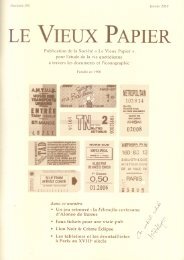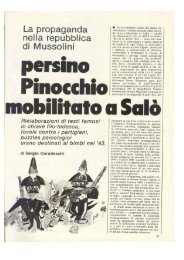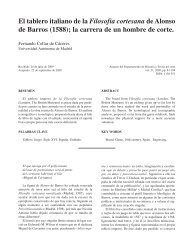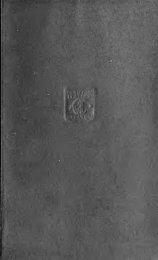Board games from the city of Vijayanagara (Hampi ... - Gioco dell'Oca.
Board games from the city of Vijayanagara (Hampi ... - Gioco dell'Oca.
Board games from the city of Vijayanagara (Hampi ... - Gioco dell'Oca.
Create successful ePaper yourself
Turn your PDF publications into a flip-book with our unique Google optimized e-Paper software.
“Juden Raus!” (Jews Out!) – History’s most<br />
infamous board game / Andrew Morris-Friedman and<br />
Ulrich Schädler<br />
Twentieth-century proprietary board <strong>games</strong> have been characterized as being based<br />
on a <strong>the</strong>me and representing an aspect <strong>of</strong> real life (Parlett 2000). Games have been<br />
designed that simulate <strong>the</strong> range <strong>of</strong> human activities, <strong>from</strong> hunting and ga<strong>the</strong>ring,<br />
to war, business and economics to human relationships. Many such <strong>games</strong> have as <strong>the</strong>ir<br />
<strong>the</strong>me <strong>the</strong> teaching <strong>of</strong> moral values (Goodfellow 1998). “The New Game <strong>of</strong> Virtue<br />
Rewarded and Vice Punished” (1820, by Darton) was one <strong>of</strong> <strong>the</strong> first mass-produced board<br />
<strong>games</strong> to reveal moral underpinnings. O<strong>the</strong>r <strong>games</strong> teach values indirectly through images<br />
used in <strong>the</strong> game design (Averbakh 1995). Most <strong>of</strong> <strong>the</strong>se <strong>games</strong> can be seen within <strong>the</strong> values<br />
perpetuated by western democracies. But any value system can be incorporated into a<br />
board game and <strong>the</strong>n used to teach whatever <strong>the</strong> game designer desires.<br />
This paper presents a brief overview <strong>of</strong> game types that must be considered racist.<br />
One such game <strong>from</strong> <strong>the</strong> Nazi period in Germany is described in detail. The game<br />
“Juden Raus!” (Jews Out!) has as its <strong>the</strong>me <strong>the</strong> persecution <strong>of</strong> <strong>the</strong> Jews in Nazi Germany<br />
and may be <strong>the</strong> most infamous board game in history. (1)<br />
Cultural historians use board game studies to document a society’s changing values<br />
over time since <strong>games</strong> exemplify <strong>the</strong> cultural values <strong>of</strong> <strong>the</strong> societies that play <strong>the</strong>m<br />
(Whitehill 1999: 116). As a result, <strong>the</strong> history <strong>of</strong> racism is reflected in <strong>the</strong> <strong>the</strong>me <strong>of</strong><br />
many board <strong>games</strong>. Some <strong>of</strong> <strong>the</strong>se <strong>games</strong> use racist images, o<strong>the</strong>rs make use <strong>of</strong> racial<br />
<strong>the</strong>mes in <strong>the</strong> rules <strong>of</strong> play. Three American <strong>games</strong> will serve as examples. Two <strong>games</strong><br />
<strong>from</strong> <strong>the</strong> Milton Bradley Company use racist images <strong>of</strong> African Americans: “The Game<br />
<strong>of</strong> Ten Little Niggers” (circa 1895) and “Snake Eyes” (circa 1930) (Whitehill 1992: 129).<br />
Both card <strong>games</strong> have racist illustrations, but racism is not an explicit <strong>the</strong>me <strong>of</strong> <strong>the</strong> game,<br />
and racist attitudes are not directly reflected in <strong>the</strong> rules (Dennis 1986).<br />
The third example “Gunsmoke” (1958, by Lowell) incorporates racist <strong>the</strong>mes in <strong>the</strong><br />
rules <strong>of</strong> play by giving one side an unfair advantage. The game depicts <strong>the</strong> mythic<br />
American confrontation between “Cowboys and Indians” each player representing one<br />
side. The pieces representing Native Americans can be “killed” and removed <strong>from</strong> <strong>the</strong><br />
game, while <strong>the</strong> Cowboy pieces can only be “captured” and are always in play. As Polizzi<br />
& Schaefer write: “The odds <strong>of</strong> winning <strong>the</strong> game are slightly in favor <strong>of</strong> <strong>the</strong> cowboys”<br />
(Polizzi 1991: 113).<br />
The principal example <strong>of</strong> racism studied here is “Juden Raus!” (Jews Out!). It was<br />
published in Germany during <strong>the</strong> Third Reich period by Gün<strong>the</strong>r & Company, Dresden,<br />
and distributed by <strong>the</strong> firm <strong>of</strong> Rudolf Fabricius at Bad Neusalza-Spremberg. Two copies<br />
<strong>of</strong> <strong>the</strong> game are known to exist. One copy is currently on display at <strong>the</strong> Museum <strong>of</strong><br />
Jewish Heritage in New York City. A second copy <strong>of</strong> <strong>the</strong> game is in <strong>the</strong> collection <strong>of</strong> <strong>the</strong><br />
Institute <strong>of</strong> Contemporary History and Wiener Library in London. Information about<br />
<strong>the</strong> game was sent to us by Acting Director Ben Barkow.







